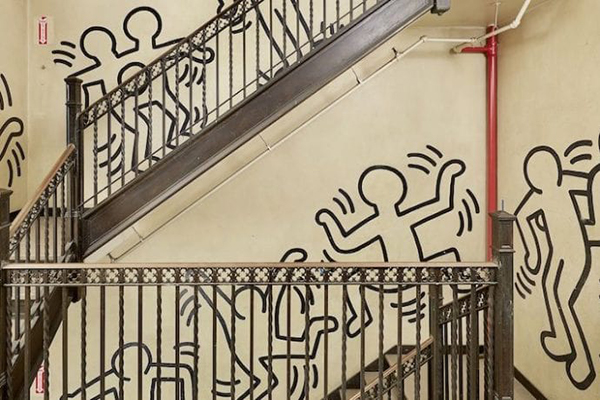
By Christopher White, National Correspondent
NEW YORK — One of Manhattan’s most LGBT-friendly Catholic parishes has sold off a mural painted by the famed pop artist Keith Haring, who died at age 31 from AIDS, for $3.9 million – a sale that its pastor hopes will ensure the doors of the church are open to everyone for many more years to come.
Although most of Haring’s work has been widely documented, the largely unknown and rarely seen three-story mural was cut from a stairwell of what was once a Catholic Youth Organization (CYO) home known as Grace House, which is also now being sold by the Church of the Ascension on the Upper West Side.
An anonymous buyer made the purchase at Bonhams Auction House in New York on November 13.
Haring, who is known for his funky and colorful cartoonlike figures of both humans and animals, created the mural in either 1983 or 1984 at the encouragement of two of his friends who lived at the house.
He received the blessing of the then-director of the CYO and the tacit consent of the parish priests, yet over the years few people that entered the doors of the place realized as they walked up and down the stairs, they were standing next to iconic American art.
The 13 figures were created with black paint, and according to current Ascension pastor Father Daniel Kearney, were in “remarkably good condition,” despite the fact that little effort was made to protect or preserve the paintings over the past three decades.
Father Kearney told The Tablet that the former pastor of the parish had been in conversations with former Cardinal Edward Egan about the possibility of preserving the murals and at the time the archdiocese had suggested putting plexi-glass over them. Funding, however, was never provided and the murals were left exposed.
Kurt Pohmer, a trustee at Ascension, said that over the past ten years the church has been hemorrhaging nearly $300,000 a year and had relied on the archdiocese both for meeting their operating costs and to make capital improvements.
As the archdiocese was merging or closing a number of parishes, Pohmer knew some significant measures were needed to keep Ascension viable and a decision was made to sell the Grace House property.
While the parish realized that Haring’s murals were an asset to the property, they were also confronted with the reality that they could be destroyed if the new owner demolished the building.
Pohmer told The Tablet that the process of extracting the murals from the property – which required cutting out the 85-foot images – and eventually putting them up for auction took about two and a half years and cost $900,000.
The sale of the murals, and eventually the house, will help pay back the archdiocese for borrowed money, cover the estimated $4.5 million in capital improvements that are still needed, and create a reserve for future needs.
Pohmer noted that the parish is now celebrating its 125-year anniversary and that by selling a part of its past, the church is also helping to secure its future.
“I think we did the right thing. We were good stewards of the murals. We’re not art dealers, that’s not our profession,” he said. “We’re here to help the community, to help people out. We have a lot of other projects to do and hopefully this parish will thrive for another 125 years.”
“We’re also keeping Keith Haring’s legacy alive,” he added.
As pastor, Father Kearney concurred, noting that while selling off property isn’t always the easiest choice to make, the decision was made in a way that was transparent to the parishioners and with concern for the art in its care.
He also pointed to a more symbolic – perhaps even providential – outcome that honors both Haring, who died prematurely in 1990, and the ongoing mission of Ascension.
“I find it kind of curious, the fact that these murals are in a building of a parish that is very LGBT friendly,” said Father Kearney. “One of the things that we try to do at Ascension is try to make everyone feel welcome.”
Father Kearney, who concludes every liturgy by telling LGBT people, divorced and remarried Catholics, and those with special needs that they are always welcome in the parish, says it’s a message that has to be explicitly stated.
“It’s almost as if the Lord has his hand in this in some way,” he told The Tablet. “I can’t help but think that as [Haring’s] legacy is being kept alive; I think there would be some amount of contentment on his part in knowing that it was this particular parish that’s preserving his legacy.”
